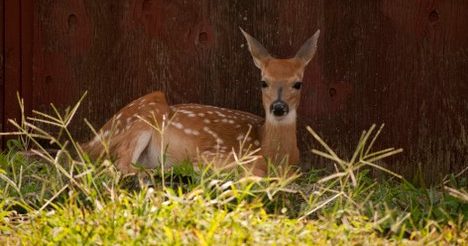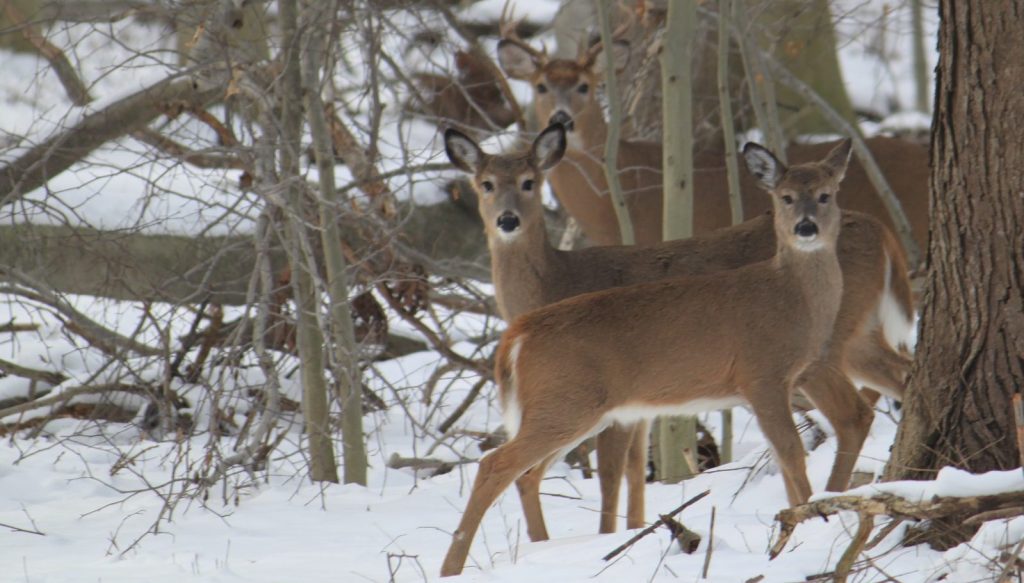 When it comes to garden pests, deer have long been Public Enemy No.1 here in central Jersey. Their unrelenting browsing disfigures trees, reduces shrubs to nubs, and obliterates our lovingly-tended beds and borders. With deer populations soaring and native habitats shrinking, deer have become a source of constant frustration for many gardeners.
When it comes to garden pests, deer have long been Public Enemy No.1 here in central Jersey. Their unrelenting browsing disfigures trees, reduces shrubs to nubs, and obliterates our lovingly-tended beds and borders. With deer populations soaring and native habitats shrinking, deer have become a source of constant frustration for many gardeners.
So what’s a Garden State gardener to do about this gnawing problem?
While there is no simple formula for battling deer damage, don’t raise the white flag just yet. Try some of these deer defying tactics instead. They might be all you need to make peace with the local herd.
Don’t give up on gardening just because deer have been snacking on your landscaping. While nothing is foolproof, there are strategies that can moderate deer damage.
Dine or Dash? It Pays to Plant Smart

As a general rule, deer tend to avoid anything in the onion family, which includes these allium. (Photo by David Byers)
To help New Jersey residents make smarter choices about the plants they install in their gardens, the folks at Rutgers Agricultural Experiment station have put together the ultimate tool for gardening in deer territory.
They’ve indexed hundreds of popular plants—all of which grow and thrive in our area– and rated them by deer resistance. But the best part is: you can tailor their list to unearth exactly the type of plants your garden needs! Were your annuals annihilated? Your perennials pulverized? Using the Rutgers online tool, just search for “annuals” (or perennials, trees, shrubs, etc.) and voila: a list of deerly-detested plants pops up. Or maybe you’re considering adding a certain plant to your garden and are wondering if it is destined to be deer fodder? You can search for it by name (using either the common name or the Latin name) and see its degree of deer delectability.
So why not do a little “browsing” of your own for a change! Click the link below to delve into Rutgers’ deer diet database:
Plants Rated by Deer Resistance
For a printable, quick-reference list of the Rutgers info, download: Landscape Plants Rated by Deer Resistance
Now that you’re armed with an arsenal of deer-distained plants, does that mean any plants tagged with the dreaded “Frequently Severely Damaged” designation are off limits? Hardly. It just means they’re best planted with a little “additional protection.” What kind of protection? Read on…
On Guard: Fencing 101
The most effective, long-term solution for thwarting Bambi and his plant-munching kin is definitely fencing. No other tactic is as successful at eliminating deer from the garden. That said, fences only work if properly built and maintained.
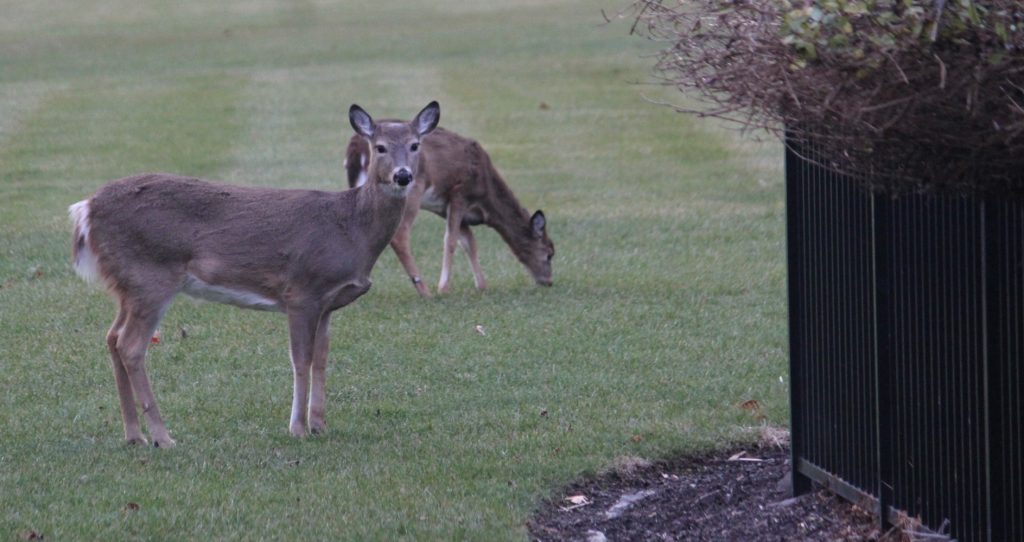
Fear the Fence: Even though deer can easily jump fences under 8 feet tall, they are normally hesitant to jump into small plots, or spaces that don’t allow them to see their landing spot–for fear they won’t be able to get out. (Photo by Margaret Montplaisir)
To successfully thwart deer incursions, fences should be at least 8 feet high, kept taut, and have no gaps. And it goes without saying that the fence must completely enclose the area you are trying to shield. Forget about fencing only one side of the property or thinking a small or remote break will go unnoticed. If there are any open sections, rest assured deer will find a way through.

An obvious–though commonly missed– component of effective deer fencing is to make sure gates are always kept securely closed. (Photo by Anne Zeman)
On the Fence About Which Enclosure You Need?
There are many types of deer fencing available–from solid stockade barriers to nearly invisible plastic mesh screens.
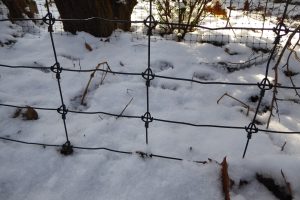
Wire fencing is long lasting and highly resistant to damage. It is also expensive to purchase and install, but can be a cost effective way to protect valuable plantings. (Photo by Anne Zeman)
Which style you choose depends on: your budget, the size of the area you are trying to protect, and the level of deer damage in your area. Also, if your property is in any way hilly, preventing gaps can be a challenging but necessary issue to address.
Regardless of the type you select, deer fencing must be properly anchored to the ground. Unlikely as it may seem, given the choice, deer are more likely to crawl under a fence than to jump over it.
Deer are opportunists and will push through any breach they find, so it’s important to examine fences frequently and fix any holes or gaps.
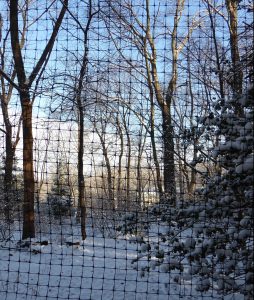
Fencing made of plastic netting is generally less expensive, and less visually obtrusive. (Photo by Anne Zeman)
There are some types of deer fencing that you can install yourself, but others–like high-tensile wire fences—require special skills and might be best left in the hands of experienced contractors.
While deer fencing can be expensive, you may find that the one-time cost of a permanent 8-ft. fence is well worth the price given the peace of mind and years of damage-free gardening it can provide.
To learn more about deer fencing, see:
High-Tensile Woven Wire Fences for Reducing Wildlife Damage
How to Build a Plastic Mesh Deer Exclusion Fence
Low-Cost Slant Fence Excludes Deer from Plantings
Amping up Deer Deterrence
Another type of deer exclusion is electric fencing. Built specifically to handle deer, high voltage electric fences can prove very effective in keeping them out. As with any fencing, proper installation and maintenance are key.
Before you consider this type of exclusion, you should know that the use of electric fencing is generally not an option in residential areas, although it is often permitted in rural locales.
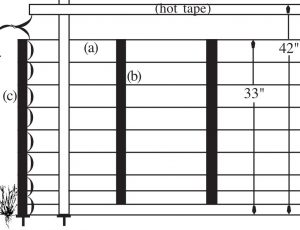
Portable electric fencing consists of conductive strands of stainless steel and nylon cord which are kept separated by plastic supports (b) a foot apart to form a “mesh-like” barrier. Fiberglass posts (c) are coupled with 5-inch steel spikes to allow them to be hand pushed into the ground to support the fence. (Illustration from Rutgers’ Portable Electric Fencing Fact Sheet #888)
Under the right circumstances, electric fences can be both effective and cost-efficient. But for safety and effectiveness, it’s best to have electric fences constructed by an experienced contractor. The price of electric fencing can vary widely depending on the style of fencing used and the size of the area that needs protecting, so it pays to shop around.
For best results, electrify the fence immediately after installation and keep it electrified at all times. If an electric fence is turned off for several days, deer may learn to go through it.
Stop Gap Measures: Portable Electrics
In addition to permanent electrified fencing, there are also portable electric fencing systems that can provide temporary protection for crops, gardens and landscaping. Most often used in smaller areas, they offer the advantage of being easy to move around, dismantle, and reassemble as needed.
For more information, download Rutgers factsheet FS888, Portable Electric Fencing for Preventing Wildlife Damage

Deer fences of any design must be checked regularly. Repairs to damaged or broken fencing should be made promptly to prevent any gaps that might allow deer to squeeze through. (Photo by Calleen Parson)
Net Gains: Protecting Individual Plants
Electrified or not, the biggest drawback to full-on deer fencing is cost. But in areas where deer density is less intense, a more cost-efficient approach might be to only “fence in” those plants that tend to get hit the hardest. Young trees, for example, are particularly sensitive to deer damage and often do not survive intensive deer browsing. Individual trees can be protected from damage by surrounding them with tree shelters or wire cages that keep vulnerable trunks and lower branches out of the DMZ (Deer Mutilation Zone.)
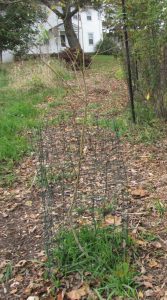
Young trees are particularly sensitive to deer damage. Protect trees below “browse line,” from ground to lower limbs.
You can remove this type of fencing once trees have branched beyond the reach of deer, or you can leave it in place to keep bucks from using young trees as their personal scratching posts when removing the felt from their antlers in the fall.
Admittedly, tree shelters and wire cages are not the most attractive additions to a home landscape, but if the damage you’re experiencing is extensive enough, and the plant you are shielding is important enough, you may be able to “look past” the wiring in order to keep your prized plant alive.
For the Birds: Help for Low Growing Plants
Another low-investment way to protect vulnerable plants and shrubs is through the use of flexible plastic or “bird” netting. Like wire caging, it too provides temporary protection for vulnerable plants but it is often less noticeable (especially from a distance) than enclosures made of hefty metal wire.
Lightweight and less substantial than wire mesh, plastic netting tends to works best in areas where deer browsing is relatively light. It is typically used to cover low-growing shrubs, groups of plants, or seasonally-harvested berries and fruit. To keep netting from blowing away and to avoid gaps, use wooden stakes or zip ties to anchor the netting over plants.
Scent-sible Solutions: Using Deer Repellents
If exclusion is not a viable option for you, repellents can be a comparatively low-cost way to steer deer from your prized plants. Repellents basically use either an unpleasant taste or odor to teach deer to avoid the yucky stuff in your yard and search out less noxious noshes elsewhere.
Repellents come in a variety of forms –from homemade concoctions to commercial ready-to-use sprays. Some are applied directly to plants and repel deer by taste. Others deter deer by scent, and are meant to keep deer from a specific area rather than a specific plant.

One deer repelling technique used by Master Gardeners at Mercer Educational Gardens, is to string absorbent barrier tape around the perimeter of each garden. The tape is then sprayed with deer repellents. Stakes ensure that the tape stays taut and is held right about deer nose level –30 inches from the ground.
Regardless, of the type or technique you use, repellents are most effective when applied before damage occurs. They also work best over relatively small areas when deer populations are on the low side.
Re-application is key for all repellents, since they tend to wear off over time and wash off quickly with rain and snow. But even with good upkeep, deer tend to get used to repellents over time, so it’s a good idea to switch to a different type of repellent — or at least one with a different active ingredient–at least once a year.
Many gardeners find that a combination of odor- and taste-based repellents provide the best benefit. For more information see:
Deer Control in Home Gardens – Repellents
Using commercial deer repellents
Repellents can reduce damage, but will not entirely eliminate damage. Deer will eat just about anything when food sources are limited.
Scare Tactics
Another strategy that might be worth a try involves devices that attempt to spook deer. Things like motion-activated sprinklers, strobe lights, and even radios have been known to send deer high-tailing for more peaceful parts.
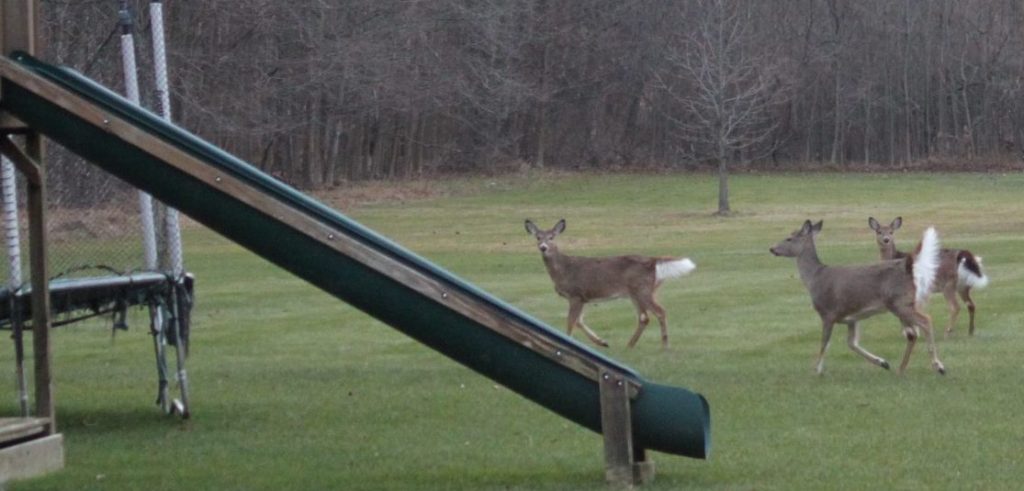
Skittish by nature, deer will often turn tail and bolt when faced with loud or startling sights and sounds.
But more often than not, scare tactics only work for a short period of time. After that, deer become accustomed to them and don’t even flinch. Sometimes though, scare tactics can give you just enough protection to allow a young plant to become established or a specific crop to be harvested.
A word to the wise: When it comes to using noise-makers, permits may be required in some areas. Check with local ordinances before installing them and–at the very least–clear it with any near-by neighbors.
Yelp Help: Using Dogs to Control Deer
Deer prefer calm, quiet areas for grazing– so a loud, barking dog in the yard can sometimes be enough to drive them off. Dog deterrence is most effective when combined with those “invisible” dog fences that allow pups to freely patrol an area and harass intruders as they attempt to move through.
Of course, dogs are only effective at discouraging deer when they are out and about at the same time as the deer. Given that deer often feed during the wee hours, in order to successfully ward off any late-night intrusions, dogs must have access to the yard at all hours.
Good as dogs can be at sending deer packing, in practice, a combination of deterrents might be more effective than relying on Fido alone.

Dogs can be very effective at repelling deer, provided they spend most of their time outdoors– and are actually interested in driving off deer. (Some dogs are more “vigilant” than others.)
Committing to Co-existing with Deer

Deer are a fact of life here in New Jersey, but by experimenting with different deer deterring strategies, you can enjoy your garden AND co-exist with any doe-eyed visitors that may wander your way.
Regardless, of the type of deterrence you deploy, when it comes to dealing with deer there are no quick fixes. So it pays to pick your battles.
Reconsidering how much damage you can live may be the first step in deciding which of the above methods will work best for your yard. It may be worth approaching deer damage with the same attitude you adopt when addressing other garden challenges– like weeds, insects or even noisy neighbors. Sometimes just changing your level of tolerance can go a long way toward a more peaceful gardening experience.
It may also help to know that things aren’t always as grim as they sometimes appear:
- Even though deer damage can look devastating in mid-winter and early spring–when browsing is at its most intense–in many instances, plants will eventually rebound.
- Corrective pruning can often minimize tree distortion; and, in the case of antler damage, as long as the bark has not been rubbed off around the entire trunk, there’s still a chance that the plant will be able to heal itself.
- In the spirit of live and let live, there may be some circumstances in which you can plant some “extras” that you wouldn’t mind “sharing”
Balancing Those Near and Deer
In the heat of “the battle for the backyard,” we can sometimes lose sight of the fact that deer are appearing more frequently in our yards because we have taken over much of their territory and removed many of the native plants that they need to survive.
To be responsible gardeners, it’s important that we strive to balance the environmental consequences of what we do in the garden with the needs of the larger ecosystem—always seeking to do the most good while inflicting the least harm.
To learn more, see: Responsible Gardening.
For additional info about deer in New Jersey, download: An Overview of White-Tailed Deer Status and Management in New Jersey



